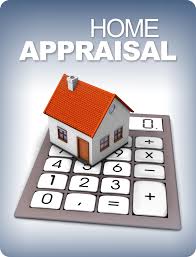The Appraisal
Please report via email any problems that you encounter with this website so that we can continue to provide you a quality experience.
The Real Estate Inspection
The real estate inspection can take anywhere from 10 minutes to over an hour, depending on your home size. The appraiser will measure the property's square footage and dimensions and will check the number of beds and baths in your home.
The appraiser also will check the status of the major systems and structure of the house. Is there water, termite, or mold damage? Is the furnace in good shape? Does the plumbing leak? Will any major systems or structures need replacement, such as the roof?
Appraisers will pay close attention to home improvements and upgrades, too. This is perhaps the most confusing area for new buyers and sellers. For example, a homeowner may add a beautiful in-ground pool and decking. In most markets, however, pools do not add any value to a home. And, in some extreme cases, they may actually hurt the home's value. This is because some buyers simply do not want pools and view them as potential maintenance and money pits.
Similarly, a house that has been modified to become unique can work against a home's value. Remember, the value of a house is largely driven by demand. While most passersby may appreciate a unique or differently designed house, far fewer want to live in one. For example, there likely would be fewer buyers if the old lady who lived in a shoe decided to sell!
Following the physical inspection, the appraiser will then double check the findings with housing data provided by local county records to ensure accuracy.
Comparables
The next step is for the appraiser to look at comparables. Comparables are similar homes that have recently sold in the general area or the specific neighborhood. Appraisers look for houses that share similar characteristics with the subject property, such as size, age, and style.
It's important to remember, however, that appraisers will only use homes listed within the past 3-6 months. The ultimate goal is to use comparables that reflect today's housing market values. By studying this data, your appraiser can then estimate your home's current worth.
The Final Report of Value
The last step in the home appraisal process is preparing a final report of value. This report will provide you and your lender with a complete property analysis. And, it will outline how an appraiser calculated your home's worth. Typically, the final report of value will include some of the following details:
- Size and condition of the house
- Comments about serious structural problems, like cracked foundations or wet basements
- Permanent fixtures, such as lights, ceiling fans, and faucets
- Details about any home renovations
- Comments about the surrounding area
- Maps, photographs, and sketches of the property
- A detailed market analysis
Who pays for the home appraisal?
While the bank will typically arrange for an appraisal, the buyer is ultimately responsible for footing the bill. Generally, appraisals cost between $300-$500, depending on the size of your home and property. It's also important to note that this fee will be collected regardless of whether or not you choose to purchase the home.
But don't worry. The home appraisal only comes once the buyer and seller agree on a price and sign documents to start the closing process. You don't need to do appraisals on every house you choose to bid on.
What can go wrong with appraisals?
If there is a significant difference between the agreed selling price and the appraised value of the home, your bank may decide not to fund the mortgage and the deal could fall through. The bank doesn't want you to overpay and, thus, over borrow for a home. For example, if you should need to move, this could leave you with a home worth less than you owe on it – that's a bad situation for everyone!
The Appraisal
151 Schedule Appraisal
152 Provide comparable sales used in market pricing to Appraiser
153 Follow-Up On Appraisal
154 Enter completion into transaction management program of WiseAgent.
155 Assist seller in questioning appraisal report if it seems too low
What is a home appraisal?
A home appraisal is an expert's opinion of how much your home is worth. Most lenders will require an objective, third-party, certified appraiser to determine the fair market value of a property before closing. This protects you from spending more on a home than it's actually worth. It also protects your lender from loaning out too much money.
Appraisers are trained to look at certain aspects of a home to develop a value. And, sometimes their methods and conclusions don't seem to make much sense. But, there is a method to their madness. The process typically includes:
Watch the Tutorial Video
The Appraisal Process - Viewing Time is 11:52 minutes.
How to Combat a Low Appraisal - Viewing Time is 7:16 minutes.
